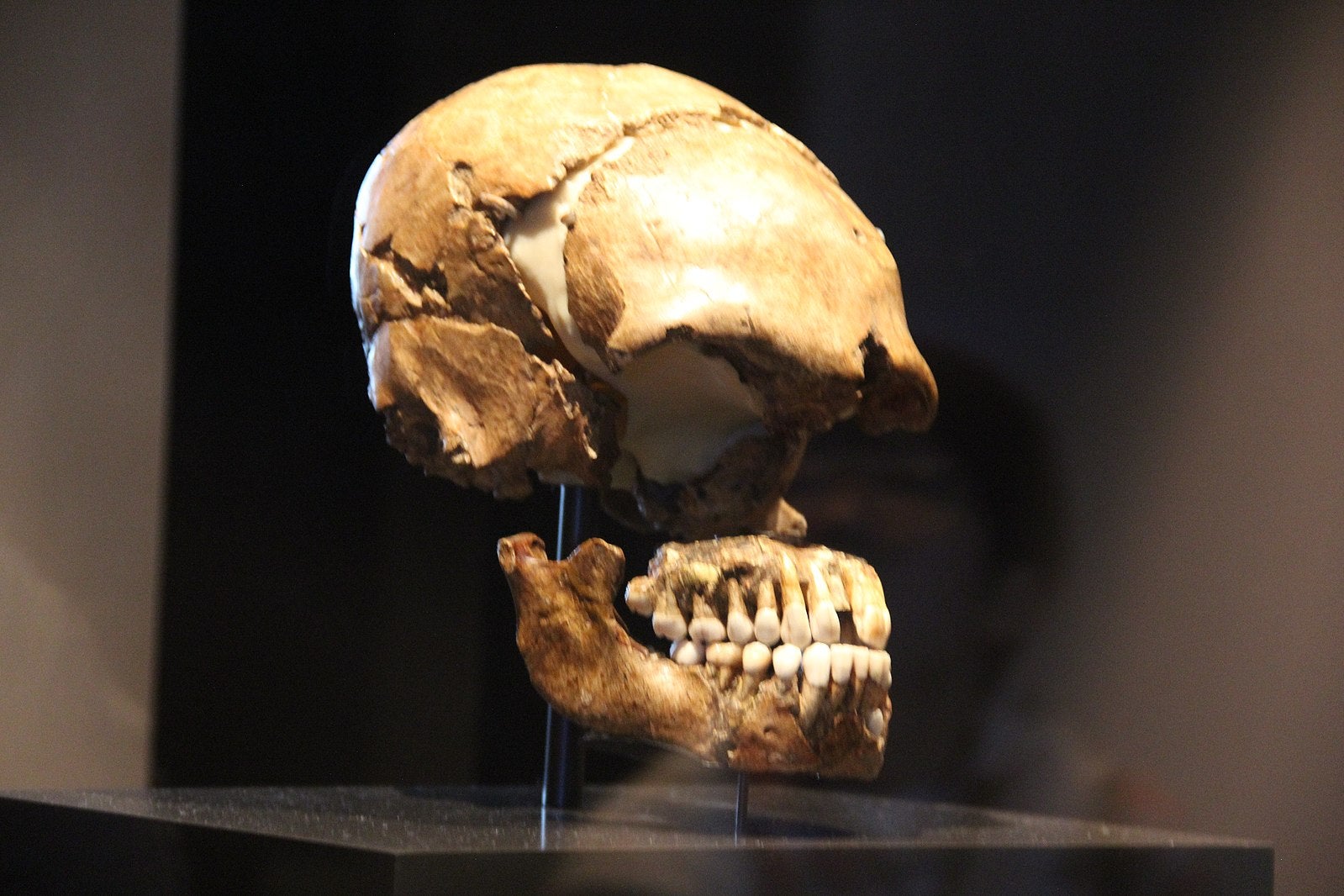Could Neanderthals hear the world the way we do?
Sabrina Imbler on why our distant ancestors’ speech and listening skills might not be too different from our own

If you were somehow able to travel back in time some 130,000 years and chance upon a Neanderthal, you might find yourself telling them about some of humanity’s greatest inventions, such as spanakopita and TikTok. The Neanderthal would have no idea what you were saying, much less talking about, but might be able to hear you perfectly, picking up on the voiceless consonants “t”, “k” and “s” that appear in many modern human languages.
A team of scientists has reconstructed the outer and middle ear of Neanderthals and concluded that they listened to the world much like we do. Their study, published last week in Nature Ecology & Evolution, found that Neanderthals had the anatomical ability to perceive a similar range of sounds as modern homo sapiens, including upper speech frequencies that mainly involve consonant production.
The authors believe this research has implications beyond the ear. Any insight into how Neanderthals heard can offer new clues into one of the most-debated, unresolved questions about the ancient hominids: whether Neanderthals spoke.
Hearing and speech are often coupled in the animal kingdom, according to Dan Dediu, a language scientist at the Lumiere University Lyon 2 in France, who was not involved with the research. “It would be meaningless for an animal to produce a frequency that can’t be heard by conspecifics,” he says.
The study offers new evidence that Neanderthals may have had some kind of recognisable spoken language, according to Sverker Johansson, a researcher at Dalarna University who was not involved with the research. “It is satisfying to find further confirmation that Neanderthals really were neander-talkers,” Johansson says.
For decades, the debate hinged on a single Neanderthal bone: the horseshoe-shaped hyoid, which is a key to speaking. The hyoid, which sits in the vocal tract, is small, fragile and not connected to any other bone. The only complete Neanderthal hyoid was recovered from a skeleton in a cave in Israel in the 1980s, and its striking similarity to a human hyoid led to a flurry of attempts to reconstruct the Neanderthal voice box and vocal tract.
But it is difficult to draw sweeping conclusions from a single fossilised bone, let alone one untethered from the skeleton and no longer held with long-lost soft tissues. “You don’t get a lot of preserved Neanderthal tongues,” says Anna Goldfield, an anthropologist and host of The Dirt podcast.
So some scientists took a different approach. Twenty years ago, Ignacio Martínez, a palaeontologist at the University of Alcala in Spain and an author on the study, had an odd idea: to study the evolution of language by reconstructing hearing in early humans.
I’m an empiricist, and unwilling to go beyond what the evidence says, but it baffles me to think they wouldn’t have had a spoken language
“It was a harebrained, and also kind of brilliant idea,” says Rolf Quam, a palaeoanthropologist at Binghamton University and an author on the study, who was working with Martínez as a graduate student at the time. The researchers didn’t know if they would be able to reconstruct a Neanderthal ear – no one had done it before – but spent the next two decades developing, testing and retesting ear models.
In the new study, the researchers used high-resolution CT scans of ear structures in five Neanderthals, 10 modern homo sapiens and nine early hominids from Sima de los Huesos, an archaeological site in what is now Spain, who lived before Neanderthals.
The team created 3D models of these ear structures and ran the measurements through a software model to calculate the sound power transmission, which describes the way sound energy moves from the environment into the ear canal and winds its way toward the cochlea – essentially how much of the sound energy ultimately makes it to your inner ear.
The researchers used this metric to calculate the occupied bandwidth, which reflects the range of frequencies in which at least 90 per cent of the sound power reaches the inner ear – the “sweet spot” of hearing, according to Quam. This sweet spot is the range we hear best in, where our ears are most tuned to sound.
The study found the Neanderthal ear’s sweet spot extended toward frequencies of 3 to 5 kHz, which are specifically dedicated to consonant production. The researchers believe this optimisation toward consonants could be a key sign that Neanderthals had verbal language.
“The use of consonants distinguishes human language from mammalian communication, which is almost completely vowels,” Quam says. “Like grunts, howls, shrieks.”
In fact, the study found Neanderthals’ sweet spot was the same as modern human hearing, whereas the early hominids from Sima de los Huesos had a hearing range somewhere between chimpanzees and modern humans.
According to the researchers’ calculations, Neanderthals most likely would have been able to hear voiceless consonants that are produced without the vocal cords. These included voiceless stops, such as “t” and “k”, and voiceless fricatives including “f”, “s” and “th”. Voiceless consonants cannot be broadcast loudly throughout a landscape – try screaming “ththth” or “sssss” – which could indicate that these consonants were used for close-by communication between members of the same species.
Even though Neanderthals had all the right anatomy to support human speech, the authors concede that Neanderthals’ physical ability does not imply mental ability, or the cognition required for human language.

“Speech isn’t necessary for language,” says Robert Berwick, a computational linguist at the Massachusetts Institute of Technology who was not involved with the study. Berwick was not convinced of the authors’ interpretation of what the reconstructed ear indicates about Neanderthal communication; in his view, the Neanderthals’ consonant-friendly sweet spot does not imply an ability to acquire human language. “If we evolved with differently shaped ears, then we’d simply make different use of the contrasts we’re still able to perceive,” he says.
The question of Neanderthal speech may never be fully resolved, even as evidence continues to accumulate. “There are no Neanderthals left to speak,” Goldfield says.
Numerous recent discoveries around the nature of Neanderthal life present a compelling case that they behaved symbolically, wearing jewellery, making cave art and burying their dead. These revelations have helped emancipate Neanderthals from the long-standing perception that the early humans were primitive brutes, a myth partly rooted in racist ideology.
For a long time, scientists tended to think there was a “jump” that separated modern humans from the rest of the biological world, such as cognition and language, Dediu says. “But Neanderthals were probably just as human as us, just in a different way.”
The most striking evidence of Neanderthal interiority lies at the back of Bruniquel Cave in France, where archaeologists found two concentric rings of broken stalagmites, traces of fire and burned bones. The stalagmites had been snapped off 176,500 years ago – a time when Neanderthals were the only humans in the area.
The intentionality of the act suggests that the site was special in some way to Neanderthals. “I’m an empiricist, and unwilling to go beyond what the evidence says," Goldfield said, "but it baffles me to think they wouldn’t have had a spoken language."
When Quam began studying Neanderthals, he visited the ear-bone fossils at museums and measured them by hand, with callipers; some of the Neanderthals included in this study he first encountered years ago in France and Israel. CT scans now make it possible to understand the fossils on a much deeper level, but Quam said it still helped to see fossils in real life as he continues to research how Neanderthals might have spoken.
© The New York Times




Join our commenting forum
Join thought-provoking conversations, follow other Independent readers and see their replies
0Comments